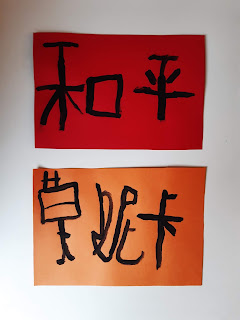Last week's project was our 100th (
Project 100: The Middle Ages), and marked the end of our second year of home education. It therefore seemed an appropriate time to look back on all the projects we have done, and reflect on how we are finding the experience.
The First 100 Projects
We all sat down as a family and looked back over the blog and the projects we have studied. The first thing that hits you is how much you can cover in two years, how much you forget, and how long it takes to look back over this blog! This was not made easier by the fact that every other blog post seemed to include at least one video the children wanted to watch again.
The children were asked to pick their favourites projects, and after a lot of whittling down they eventually settled on their favourite five.
Solomon's top five:
Monica's top five:
It's quite nice that three of Monica's picks are actually from before she was officially being home educated - it emphasises the fact that home education is something that you do as a family rather than revolving around one-to-one teaching.
In many ways the five 'favourites' felt quite arbitrary: they initially marked so many of the projects as favourites that the term was virtually meaningless (with the possible exception of
Project 1: History of Computer Games which in Solomon's opinion we are destined never to surpass).
The Second Year is Easier and Busier!
Our approach to home education in the second year is the same as the first: writing and maths every day, afternoon rest time/reading time and a weekly project (
see How We Home Educate). The writing and maths tends to be done on a one-to-one basis, so now having two children to home educate does mean it takes longer than in year one, but as they get bigger they inevitably need less supervision during other parts of the day, so it balances itself out overall.
If there is one noticeable difference from our first year of home ed, it's how many more activities there are now. This is not just within the home education community, but also with other groups such as music lessons, Beavers, and Rainbows. As a home educating parent you inevitably worry about the social aspect, school may not be natural but it is considered normal, and when you start home educating the relationships and networks don't all naturally spring into being on day one. They will, however, build up naturally over time and by the end of the second year you are more likely to have too many rather than too few social commitments.
Not Stopping Yet
When we first discussed the idea of home educating our children, it was based on the idea that school in the UK started at too young an age, and we agreed to home educate for a couple of years before reassessing the situation. Two years on and school is further from our mind than ever: we are all enjoying the home education experience as a family, and the children are thriving academically. Of course 'thriving academically' is difficult to quantify outside the increasingly test based culture of the school environment, but as our five year old happily reads Mary Poppins on her own, and our six year old is coming to the end of key stage 2 maths, we can happily risk a few more years of home education.














